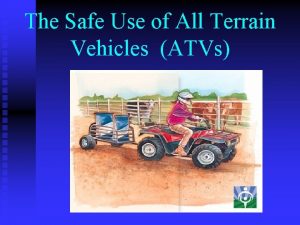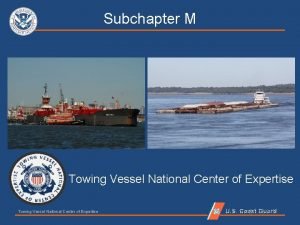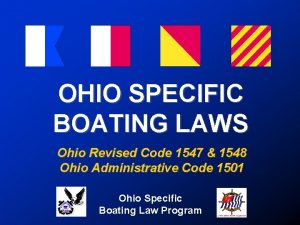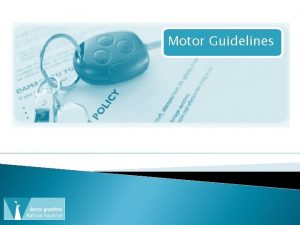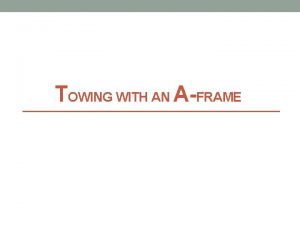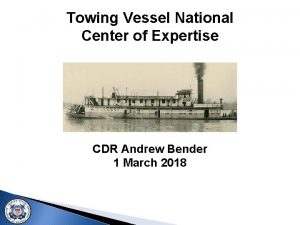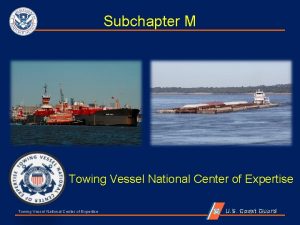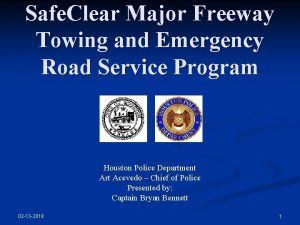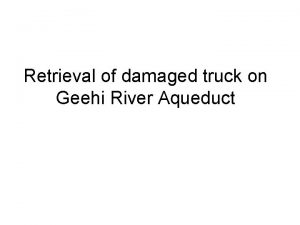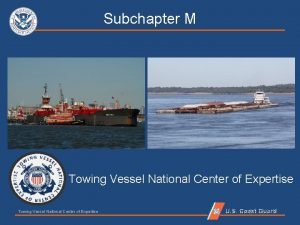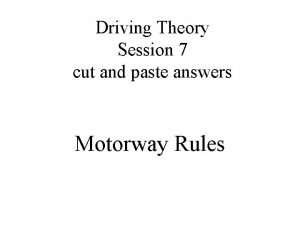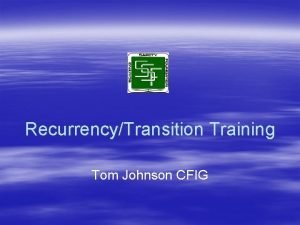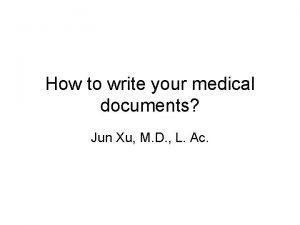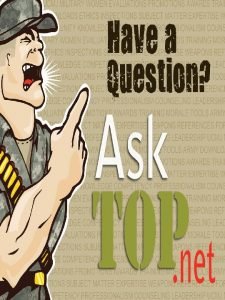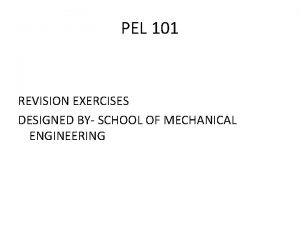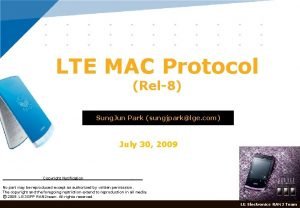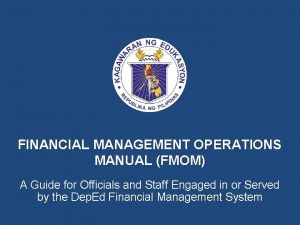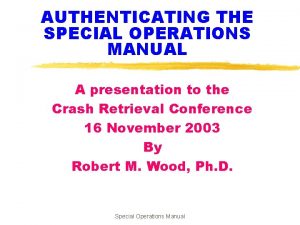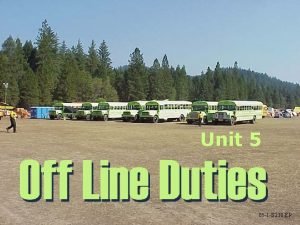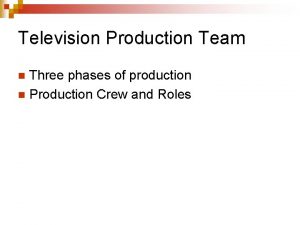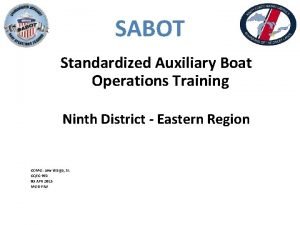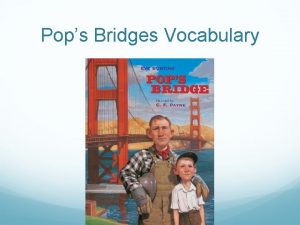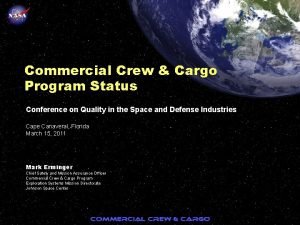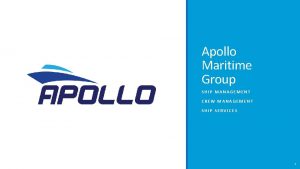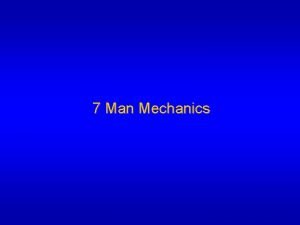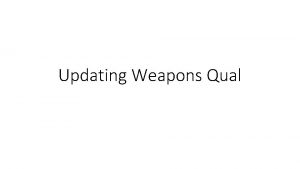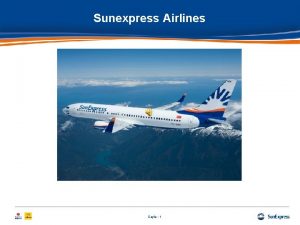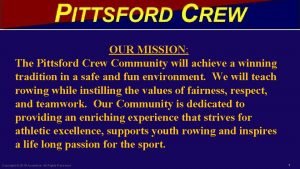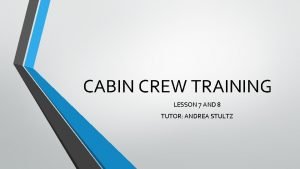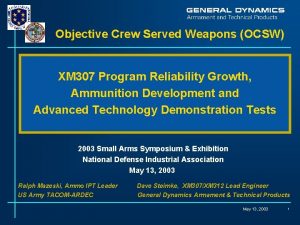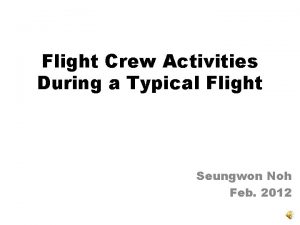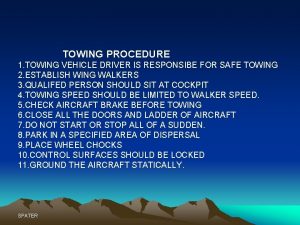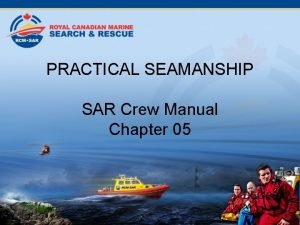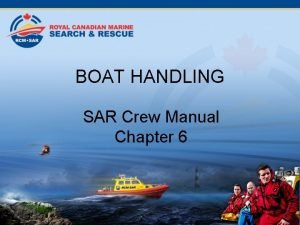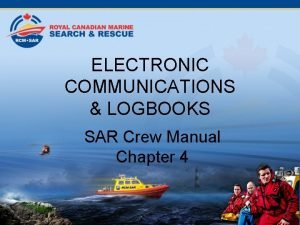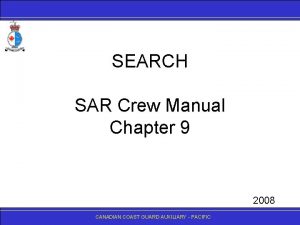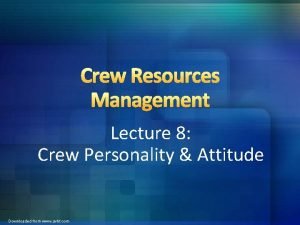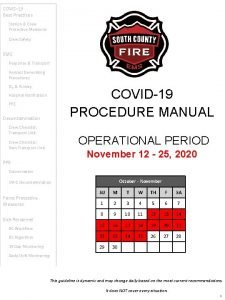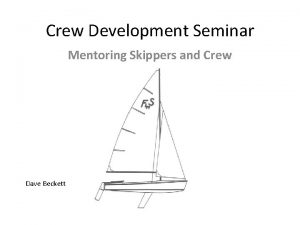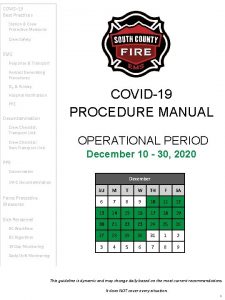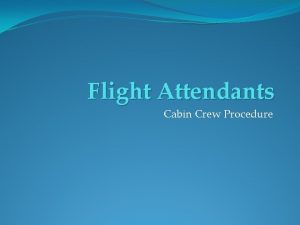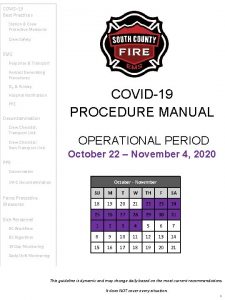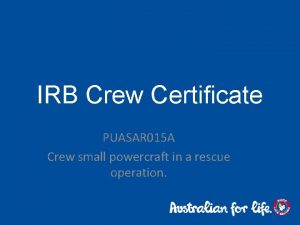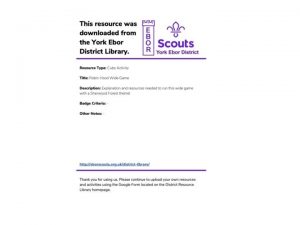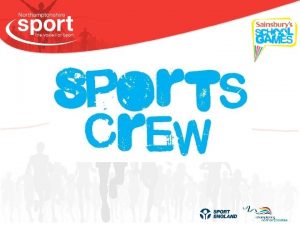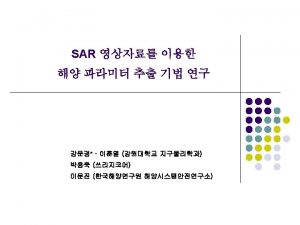TOWING OPERATIONS SAR Crew Manual Chapter 8 Jun

























































- Slides: 57

TOWING OPERATIONS SAR Crew Manual Chapter 8 Jun 2010 CANADIANCOASTGUARDAUXILIARY- -PACIFIC

CANADIAN COAST GUARD AUXILIARY - PACIFIC

Towing Operations • Towing operations can turn from routine to deadly very quickly • Crew must always be vigilant and be ready to react immediately if the operation goes wrong CANADIAN COAST GUARD AUXILIARY - PACIFIC

Towing Operations • On approach to the vessel being towed for anybody who may be already in the water • Always conduct a full 360° circle with the Stop, Assess, Plan prior to approaching a vessel requiring a tow • This is to be followed by a Pre Tow Briefing, and allocation of duties to the crew by the coxswain, with the Line Handler in charge. CANADIAN COAST GUARD AUXILIARY - PACIFIC

Towing Operations • This helps the crew to work together and promote positive communication • Thoroughly check all towing gear before moving in to pass the tow CANADIAN COAST GUARD AUXILIARY - PACIFIC

Towing Safety • The tow line can be dangerous and can kill • Check all towing gear is in good condition • Never wear gloves when making fast or adjusting the tow line • Never stand in the bight • The towing vessel must be making no way when securing the tow line on the post • Stay out of the line of recoil in case the line breaks CANADIAN COAST GUARD AUXILIARY - PACIFIC

Towing Safety • Always use your own tow line • Attach the towline to strong points on the towed vessel • Never use locking hitches on the towline • Take all way off the towing vessel when adjusting the length of tow rope CANADIAN COAST GUARD AUXILIARY - PACIFIC

Towing Questions • Questions to be asked of person on board vessel to be towed are: 1. Is everyone accounted for - how many? 2. Any injuries requiring treatment? 3. What is the nature of the problem? 4. Is the vessel taking on any water? 5. Is the vessel stable for towing? CANADIAN COAST GUARD AUXILIARY - PACIFIC

Towing Questions 6. Does the vessel have lights or searchlight? 7. Are all hatches and doors secure? 8. What is the vessel’s hull speed? 9. Where is the vessel from and where does it need to go? 10. What VHF channels are available? CANADIAN COAST GUARD AUXILIARY - PACIFIC

Towing Questions 11. Does the vessel have a shaft brake? 12. What are the best securing points for the tow (if any)? 13. Are the towed vessel’s crew able to secure the towline? CANADIAN COAST GUARD AUXILIARY - PACIFIC

Information to Pass to Tow 1. We will tow you to…. . 2. Verbal or written towing waiver given and agreed 3. Everyone to wear their lifejacket or PFD 4. Inspect all vessel and void spaces for flooding 5. Close and secure all doors and hatches CANADIAN COAST GUARD AUXILIARY - PACIFIC

Information to Pass to Tow 6. Maintain listening watch on VHF channel …… and 7. Check in with towed vessel regularly 8. Set up alternative communication 9. Turn on navigation lights 10. Secure rudder amidships or steer for towing vessel’s stern CANADIAN COAST GUARD AUXILIARY - PACIFIC

Information to Pass to Tow 11. Secure propellor shaft, or fold propellor blades if possible 12. Prepare to take the towline as we pass …… 13. Secure the line to ……………. . And advise when it is secure 14. All crew to stay inboard and keep weight low in the vessel CANADIAN COAST GUARD AUXILIARY - PACIFIC

Towing Operations • The principal positions are: 1. Helm - controlling the vessel safely during the approach, and then the tow 2. Tow Watch - must watch the tow at all times for anything unusual 3. Line Handler - prepares, and passes the towline. Controls the line during the tow CANADIAN COAST GUARD AUXILIARY - PACIFIC

Heaving Lines • Use a heaving line to throw to the vessel to be towed, to then act as a messenger for the main tow line CANADIAN COAST GUARD AUXILIARY - PACIFIC

Tow Assist Hook CANADIAN COAST GUARD AUXILIARY - PACIFIC

Crossing the “T” DIRECTION OF WIND & HEAVY SEAS • Light to heavy conditions CANADIAN COAST GUARD AUXILIARY - PACIFIC

45 -Degree Approach • light to moderate conditions CANADIAN COAST GUARD AUXILIARY - PACIFIC

Parallel Approach Wind Direction • Light to moderate conditions CANADIAN COAST GUARD AUXILIARY - PACIFIC

Back Down Approach CANADIAN COAST GUARD AUXILIARY - PACIFIC

Making Fast Towline • Before making fast the towline to the tow post on the towing vessel, the towing vessel must be stopped • Do not wear gloves when making fast the towline. • Keep the helm informed as to how much rope is in the water, whether it is close to the propeller, and whether it is safe to come ahead on the engines CANADIAN COAST GUARD AUXILIARY - PACIFIC

Making Fast Towline 1 One full turn anti clockwise around the post, under both ears and then above starboard ear CANADIAN COAST GUARD AUXILIARY - PACIFIC

Making Fast Towline 2 First part of first figure eight, under port ear, up and over CANADIAN COAST GUARD AUXILIARY - PACIFIC

Making Fast Towline 3 Second part of first figure eight, under starboard ear, up and over. CANADIAN COAST GUARD AUXILIARY - PACIFIC

Making Fast Towline 4 First part of second figure eight, under port ear, up and over. CANADIAN COAST GUARD AUXILIARY - PACIFIC

Making Fast Towline 5 Take line around under starboard ear, around back of tow post, and back over the top of the port ear. CANADIAN COAST GUARD AUXILIARY - PACIFIC

Making Fast Towline 6 Tighten up loop around. Line may be held, or dropped to hang under lines own weight CANADIAN COAST GUARD AUXILIARY - PACIFIC

Making Fast Towline 7 The DANGER AREA if the line breaks, is everywhere to the starboard side of the tow post and aft of the tow post. The line handler is to stand to port side and forward of the tow post. CANADIAN COAST GUARD AUXILIARY - PACIFIC

CANADIAN COAST GUARD AUXILIARY - PACIFIC

Towline Length • A catenary is important to have in the towline between the towing and towed vessels, as it acts as a shock absorber • The longer the towline, the bigger the catenary CANADIAN COAST GUARD AUXILIARY - PACIFIC

CANADIAN COAST GUARD AUXILIARY - PACIFIC

Towline Length • Extreme stress is placed on the towline if the towed vessel and the towing vessel are out of synch with their position in the sea or swell • Try to get the vessels in step CANADIAN COAST GUARD AUXILIARY - PACIFIC

Towing In Step CANADIAN COAST GUARD AUXILIARY - PACIFIC

Towing Out of Step CANADIAN COAST GUARD AUXILIARY - PACIFIC

Towing in Heavy Seas • If towing with a large following sea, it may be necessary to deploy a drogue from the stern of the towed vessel, to control its speed surfing down a wave, as there is a danger of it broaching and capsizing CANADIAN COAST GUARD AUXILIARY - PACIFIC

Drogues CANADIAN COAST GUARD AUXILIARY - PACIFIC

Towing Speed • If the towing speed is reduced, the strain on the tow rope is reduced, and the catenary is increased. • Do not try to tow a vessel faster than its hull speed CANADIAN COAST GUARD AUXILIARY - PACIFIC

Towing Operations • If necessary lengthen the tow line. • The catenary of the rope (the amount it hangs between the two vessels) will absorb greater shock and reduce the shocks on the towline. CANADIAN COAST GUARD AUXILIARY - PACIFIC

Towing Log Entries • The log must be well kept to counter any legal claims that arise from disputes during the towing operation. • Items to be logged include: 1. the consent to tow, 2. weather and sea conditions, 3. reasons for the tow, CANADIAN COAST GUARD AUXILIARY - PACIFIC

Towing Log Entries 4. danger the towed vessel was in, 5. existing damage, 6. number of persons on board 7. destination 8. positions every 15 minutes 9. change of tow set up or length 10. change of weather CANADIAN COAST GUARD AUXILIARY - PACIFIC

Towing - JRCC SITREPs • Keep JRCC or MCTS informed at regular intervals during a tow, with position and ETA. CANADIAN COAST GUARD AUXILIARY - PACIFIC

Towing Alongside • Towing alongside is most appropriate when the manoeuvring the towed vessel into a dock or berth CANADIAN COAST GUARD AUXILIARY - PACIFIC

Towing Alongside • Stern must be well behind other vessel • Slight angle out helps provide leverage CANADIAN COAST GUARD AUXILIARY - PACIFIC

Towing Alongside • If possible the headline, forward spring and sternline should be rigged as slip ropes, or so that the eye is on the towed vessel and the other end is belayed onboard the towing vessel, so that control of the line stays onboard the towing vessel. CANADIAN COAST GUARD AUXILIARY - PACIFIC

Towing Alongside CANADIAN COAST GUARD AUXILIARY - PACIFIC

Towing Alongside • If you want to turn to port, turn the towing vessels engines to port and go ahead Engine Thrust CANADIAN COAST GUARD AUXILIARY - PACIFIC

Towing Alongside • If you want to turn to starboard, turn the towing vessels engines to port and go astern Engine Thrust CANADIAN COAST GUARD AUXILIARY - PACIFIC

Advanced Towing CANADIAN COAST GUARD AUXILIARY - PACIFIC

Advanced Towing • There a number of advanced towing techniques that are available in certain situations CANADIAN COAST GUARD AUXILIARY - PACIFIC

Two FRCs, One Tow CANADIAN COAST GUARD AUXILIARY - PACIFIC

Two FRCs, One Tow • There are occasions when faced with a big tow, and two FRCs are available that this technique is used. • It can useful in shortening the duration of a tow. • It can also be of use where the tow is yawing excessively e. g. damaged rudder on the casualty - the two towing vessels tend to remove some of this tendency. CANADIAN COAST GUARD AUXILIARY - PACIFIC

Two FRCs, One Tow Collision area CANADIAN COAST GUARD AUXILIARY - PACIFIC

Two FRCs, One Tow • It is best that each individual FRC is made fast to a separate strong point on deck, to not overload structure on the tow. • The two towing vessels should end up about 30 feet apart. In all conditions, the distance apart of the two towing vessels must be monitored. CANADIAN COAST GUARD AUXILIARY - PACIFIC

Towing Operations • Be prepared in case the tow founders. • If the towed vessel yaws badly, she can capsize in seconds. • In addition she could pull the towing vessel sideways and capsize her. • If this occurs be ready to let go the towline or if necessary cut the towline close to the bollard. CANADIAN COAST GUARD AUXILIARY - PACIFIC

Towing Operations CANADIAN COAST GUARD AUXILIARY - PACIFIC

What is wrong in this photograph? Locking hitch on tow post Towing too fast CANADIAN COAST GUARD AUXILIARY - PACIFIC

Too big to tow? CANADIAN COAST GUARD AUXILIARY - PACIFIC
 Sar value
Sar value All terrain vehicle towing capacity 1050lbs
All terrain vehicle towing capacity 1050lbs Towing tunica
Towing tunica Ohio revised code reckless operation
Ohio revised code reckless operation Gr 47 towing charges
Gr 47 towing charges Orange county towing and transportation
Orange county towing and transportation Towing a frame suppliers
Towing a frame suppliers Uscg tvncoe
Uscg tvncoe Towing vessel center of expertise
Towing vessel center of expertise Freddie mac towing
Freddie mac towing Safe clear towing
Safe clear towing Heavy towing wagga
Heavy towing wagga Towing vessel center of expertise
Towing vessel center of expertise Iceberg
Iceberg Colour of reflective studs between motorway and slip road
Colour of reflective studs between motorway and slip road Qpt towing
Qpt towing Jun akizaki ppt
Jun akizaki ppt Yt
Yt Ene feb mar
Ene feb mar Jun akizaki ppt
Jun akizaki ppt Jun s. liu
Jun s. liu Jun xu md
Jun xu md Jun akizaki
Jun akizaki Vehicle load card
Vehicle load card Chua jun yi
Chua jun yi Brainybetty
Brainybetty Jun cao
Jun cao Daniel jun
Daniel jun Jun flores
Jun flores Happening umjetnost
Happening umjetnost Itanium benchmark
Itanium benchmark Gimnasio jun
Gimnasio jun Jun sik his teeth before breakfast every morning
Jun sik his teeth before breakfast every morning Dtch lte
Dtch lte Financial management operations manual deped
Financial management operations manual deped Opnac bbs-01
Opnac bbs-01 Ieee mga operations manual
Ieee mga operations manual Crew method of weeding
Crew method of weeding S-230 crew boss quizlet
S-230 crew boss quizlet Tv production team
Tv production team Piw crew
Piw crew Multiprocessor
Multiprocessor Pops bridge
Pops bridge Film art department hierarchy
Film art department hierarchy Commercial crew and cargo program
Commercial crew and cargo program Cabin crew training malaysia
Cabin crew training malaysia Apollo ship management
Apollo ship management Anemia
Anemia Umpirer
Umpirer Crew served weapons qualification
Crew served weapons qualification Sunexpress safety
Sunexpress safety Pittsford crew
Pittsford crew Cabin crew commands
Cabin crew commands Dell student tech crew
Dell student tech crew Weeding crew
Weeding crew Objective crew served weapon
Objective crew served weapon Crew activities
Crew activities

